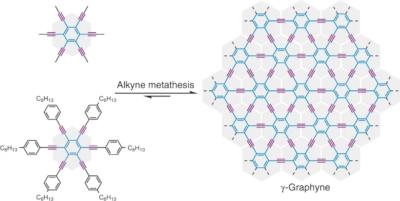Researchers at the University of Colorado Boulder and Qingdao University of Science and Technology have managed to synthesize an illusive form of carbon called graphyne. Graphyne has long been of interest to scientists because of its similarities to graphene. However, despite decades of work and theorizing, only a few fragments have ever been created before now.

"The whole audience, the whole field, is really excited that this long-standing problem, or this imaginary material, is finally getting realized," said Yiming Hu, lead author on the paper.
Zhang, a professor of chemistry at CU Boulder, studies reversible chemistry, which is chemistry that allows bonds to self-correct, allowing for the creation of novel ordered structures, or lattices, such as synthetic DNA-like polymers.
Creating graphyne is a "really old, long-standing question, but since the synthetic tools were limited, the interest went down," Hu, who was a Ph.D. student in Zhang's lab group, commented. "We brought out the problem again and used a new tool to solve an old problem that is really important."
Using a process called alkyne metathesisâwhich is an organic reaction that entails the redistribution, or cutting and reforming, of alkyne chemical bonds (a type of hydrocarbon with at least one carbon-carbon triple covalent bond)âas well as thermodynamics and kinetic control, the group was able to successfully create what had never been created before: A material that could rival the conductivity of graphene but with control.
"There's a pretty big difference (between graphene and graphyne) but in a good way," said Zhang. "This could be the next generation wonder material. That's why people are very excited."
While the material has been successfully created, the team still wants to look into the particular details of it, including how to create the material on a large scale and how it can be manipulated.
"We are really trying to explore this novel material from multiple dimensions, both experimentally and theoretically, from atomic-level to real devices," Zhang said of next steps.
These efforts, in turn, should aid in figuring out how the material's electron-conducting and optical properties can be used for industry applications like lithium-ion batteries.
"We hope in the future we can lower the costs and simplify the reaction procedure, and then, hopefully, people can really benefit from our research," said Hu.
Zhang stressed the importance of the support of an interdisciplinary team, adding: "Without the support from the physics department, without some support from colleagues, this work probably couldn't be done."

